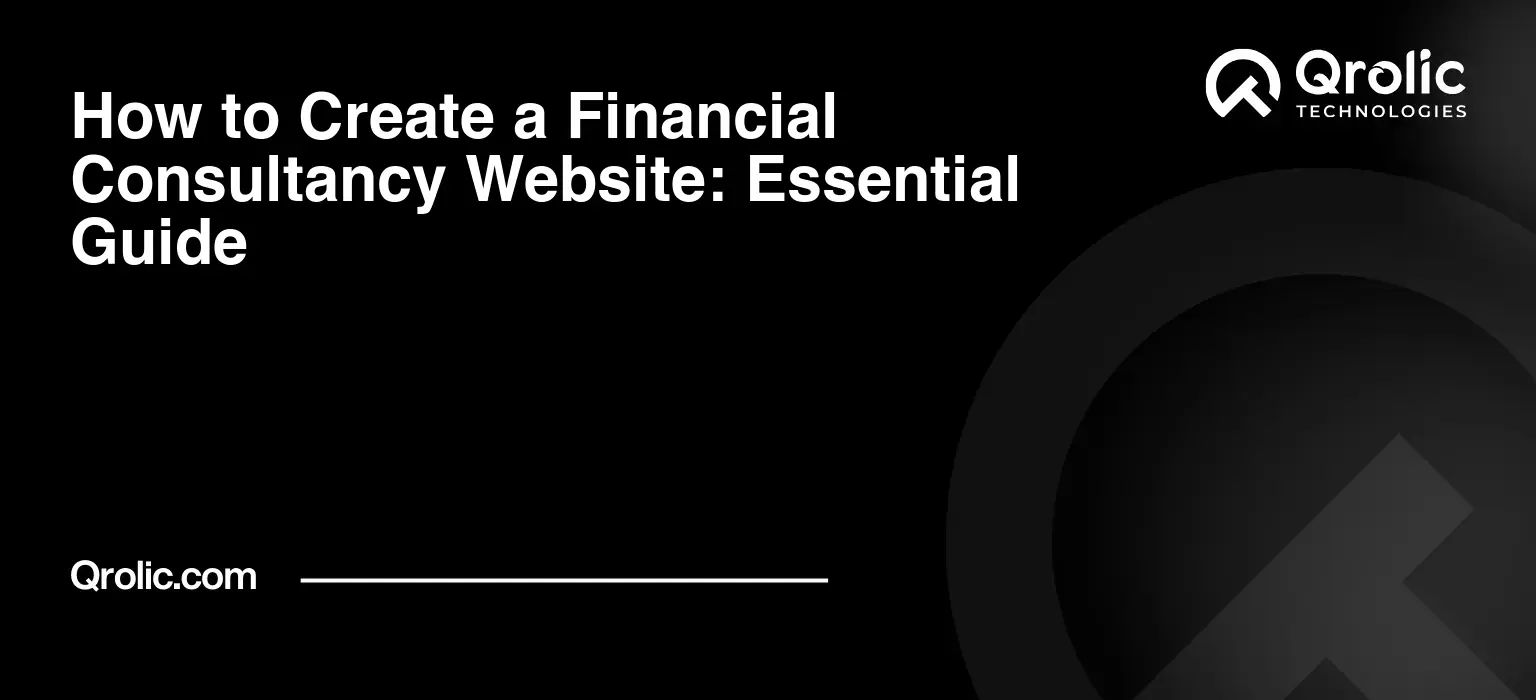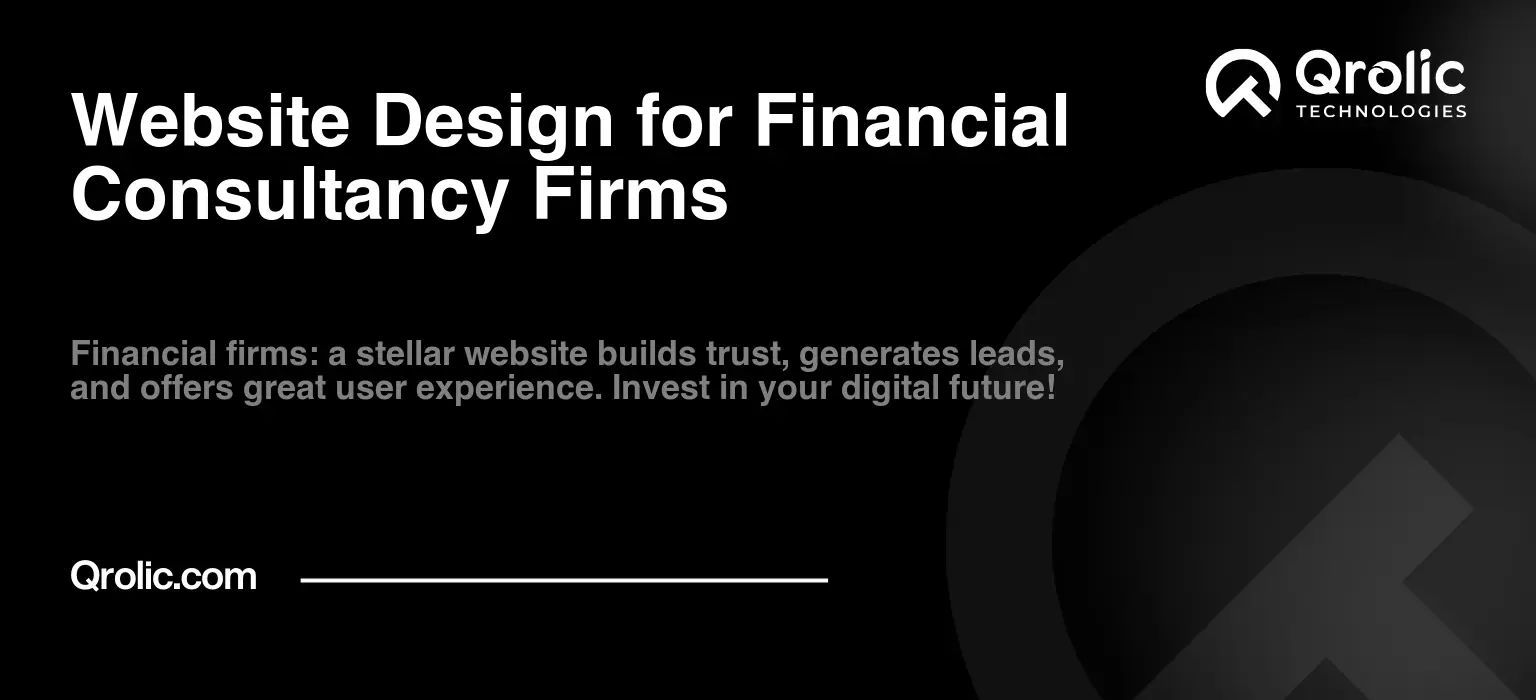The world of finance can feel intimidating. Your website is often the first interaction a potential client has with your firm, and it needs to scream trust, competence, and approachability. It needs to assure them that you understand their anxieties and have the solutions they crave.
This essential guide breaks down every step of creating a financial consultancy website that attracts, converts, and establishes you as a leader in your field. We’ll move beyond just aesthetics and delve into the psychology of website design for finance, ensuring your site resonates with your ideal client.
Quick Summary:
- Define goals, audience, and analyze competitors first.
- Build a user-friendly, mobile-responsive website.
- Create valuable content and optimize for SEO.
- Prioritize trust, security, and lead generation.
Table of Contents
- I. Defining Your Financial Consultancy Website’s Purpose and Audience: Laying the Foundation for Success
- A. Identifying Your Primary Website Goals: What Do You Want to Achieve?
- B. Defining Your Target Audience: Understanding Your Ideal Client
- C. Competitive Analysis: Learning from the Best (and the Worst)
- II. Website Structure and Navigation: Creating a User-Friendly Experience
- A. Planning Your Website Architecture: The Foundation of Navigation
- B. Designing Intuitive Navigation: Guiding Visitors Through Your Website
- C. Optimizing for Mobile Devices: Reaching Your Audience on the Go
- III. Content Creation and SEO: Attracting and Engaging Your Target Audience
- A. Developing a Content Strategy: Planning Your Content Calendar
- B. Writing Compelling and Informative Content: Engaging Your Visitors
- C. Optimizing for Search Engines (SEO): Getting Found Online
- D. Local SEO for Financial Consultants: Targeting Your Local Market
- IV. Design and Branding: Creating a Professional and Trustworthy Image
- A. Choosing a Professional Website Theme or Template: Setting the Visual Tone
- B. Creating a Consistent Brand Identity: Building Recognition and Trust
- C. Optimizing Website Speed and Performance: Ensuring a Smooth User Experience
- V. Key Website Elements for Financial Consultancies: Essential Features for Success
- A. Lead Capture Forms and Calls-to-Action: Converting Visitors into Leads
- B. Client Testimonials and Case Studies: Building Trust and Credibility
- C. Security and Compliance: Protecting Sensitive Information
- D. Blog and Resource Center: Providing Value and Establishing Expertise
- VI. Maintaining and Promoting Your Website: Ensuring Long-Term Success
- A. Regularly Updating Content: Keeping Your Website Fresh and Relevant
- B. Promoting Your Website Online: Driving Traffic and Generating Leads
- C. Monitoring Website Analytics: Measuring Your Success and Identifying Areas for Improvement
- VII. Qrolic Technologies and Your Financial Consultancy Website
- VIII. Final Thoughts: Building a Website That Builds Your Business
I. Defining Your Financial Consultancy Website’s Purpose and Audience: Laying the Foundation for Success
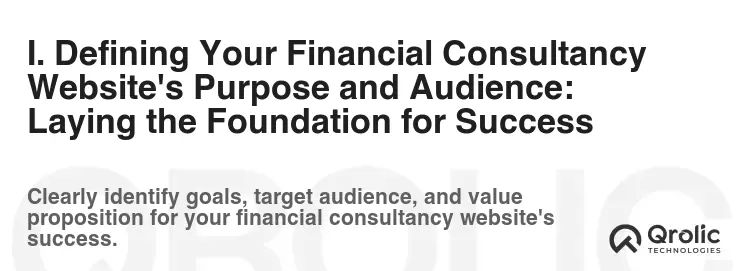
Before you even think about fonts and colors, you need a rock-solid foundation. This begins with understanding why you need a website and who you are trying to reach.
A. Identifying Your Primary Website Goals: What Do You Want to Achieve?
Think beyond simply having an online presence. What concrete actions do you want visitors to take?
- Lead Generation: Are you primarily focused on generating qualified leads for your services? If so, your website needs clear calls-to-action (CTAs) and compelling lead magnets (free resources offered in exchange for contact information). Think “Download our free retirement planning checklist” or “Schedule a free consultation.”
- Brand Building: Are you more interested in establishing yourself as a thought leader and building brand awareness? This requires a strong focus on content marketing, including blog posts, articles, and videos that showcase your expertise.
- Client Education: Is your website meant to educate potential clients about complex financial concepts and your services? This necessitates clear, concise, and easily digestible content, often supplemented with infographics and interactive tools.
- Portfolio Showcase: If you have a strong track record, showcasing your successes is crucial. Client testimonials, case studies, and performance reports (while maintaining confidentiality, of course) can build credibility.
- Direct Client Acquisition: Can clients directly purchase your services or schedule appointments through your website? This requires e-commerce functionality and a seamless online booking system.
Example: A new financial advisor targeting young professionals might prioritize lead generation and client education, while an established firm with a strong reputation might focus on brand building and showcasing past successes.
B. Defining Your Target Audience: Understanding Your Ideal Client
Knowing who you’re talking to is just as important as what you’re saying. Create detailed “client personas” that represent your ideal customers.
- Demographics: Age, income, education level, location, occupation.
- Financial Goals: Retirement planning, investment management, tax optimization, estate planning, debt management, starting a business.
- Pain Points: What are their biggest financial anxieties and challenges? Lack of knowledge, fear of making mistakes, feeling overwhelmed, lack of time, uncertainty about the future.
- Values: What’s important to them? Security, independence, family, social responsibility.
- Online Behavior: Where do they spend their time online? What are they searching for? What kind of content do they consume?
Example:
Persona: Sarah, the Young Professional
- Age: 28
- Occupation: Marketing Manager
- Income: $75,000
- Financial Goals: Saving for a down payment on a house, paying off student loans, starting to invest for retirement.
- Pain Points: Feels overwhelmed by the complexity of investing, doesn’t have much time to manage her finances, worried about making mistakes.
- Values: Independence, convenience, transparency.
- Online Behavior: Spends time on social media (Instagram, LinkedIn), reads personal finance blogs, uses mobile banking apps.
Keywords relevant to Sarah: Financial planning for millennials, student loan repayment strategies, first-time homebuyer advice, beginner investing tips.
Understanding Sarah’s needs and online behavior allows you to tailor your website content, design, and marketing efforts to resonate with her.
C. Competitive Analysis: Learning from the Best (and the Worst)
Don’t reinvent the wheel. Research your competitors’ websites. What are they doing well? What are they doing poorly?
- Identify Your Competitors: Search online for financial advisors in your area and those targeting the same audience.
- Analyze Their Websites:
- Design and User Experience: Is the website visually appealing and easy to navigate?
- Content: What kind of content do they offer? Is it informative and engaging?
- SEO: What keywords are they targeting? How well do they rank in search results?
- Call-to-Actions: What actions do they want visitors to take? Are their CTAs clear and compelling?
- Social Proof: Do they showcase testimonials, case studies, or awards?
- Identify Opportunities: Where can you differentiate yourself? What gaps can you fill?
Example: You might notice that many of your competitors have outdated websites with confusing navigation. This presents an opportunity to create a modern, user-friendly website that stands out from the crowd.
II. Website Structure and Navigation: Creating a User-Friendly Experience
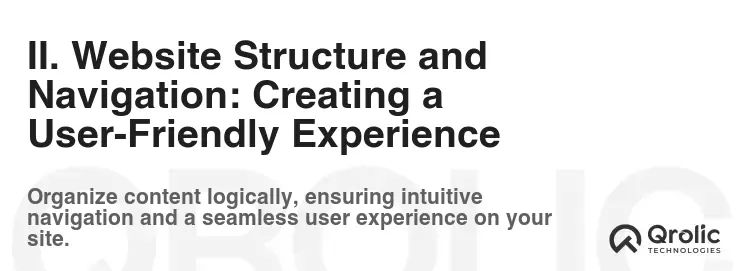
A beautiful website is useless if visitors can’t find what they’re looking for. A clear and intuitive website structure is essential for a positive user experience.
A. Planning Your Website Architecture: The Foundation of Navigation
Think of your website as a building. You need a solid architectural plan before you start construction.
- Homepage: The first impression matters. It should clearly communicate your value proposition, highlight your key services, and guide visitors to the most important pages.
- About Us: Tell your story. Build trust by showcasing your expertise, experience, and values. Include photos of your team to personalize your brand.
- Services: Clearly outline the services you offer, explaining the benefits to the client. Use clear, concise language and avoid jargon.
- Blog/Resources: Position yourself as a thought leader by providing valuable content that addresses your target audience’s pain points.
- Testimonials/Case Studies: Let your satisfied clients speak for you. Social proof is a powerful tool for building trust.
- Contact Us: Make it easy for visitors to get in touch. Include a contact form, phone number, email address, and physical address (if applicable).
Example Website Structure:
- Homepage
- Headline: “Helping You Achieve Your Financial Goals”
- Brief overview of services
- Client testimonials
- Call-to-action: “Schedule a Free Consultation”
- About Us
- Our Mission and Values
- Team Bios and Expertise
- Our Approach to Financial Planning
- Services
- Retirement Planning
- Investment Management
- Tax Planning
- Estate Planning
- Blog
- Articles on various financial topics
- Testimonials
- Client success stories
- Contact Us
- Contact Form
- Phone Number
- Email Address
- Office Location (if applicable)
B. Designing Intuitive Navigation: Guiding Visitors Through Your Website
Your navigation should be clear, concise, and consistent across all pages.
- Main Navigation Menu: Keep it simple and limit the number of items. Use clear and descriptive labels.
- Dropdown Menus: Use them sparingly, as they can be overwhelming.
- Footer Navigation: Include important links, such as your privacy policy, terms of service, and contact information.
- Internal Linking: Link to relevant pages within your website to improve SEO and user experience.
- Search Bar: Make it easy for visitors to find specific information.
- Breadcrumbs: Help visitors understand their current location within the website.
- Mobile-Friendly Navigation: Ensure your navigation is easy to use on smartphones and tablets.
Example: Instead of labeling a navigation item “Solutions,” use “Investment Management” or “Retirement Planning.” Be specific and use keywords that your target audience is likely to search for.
C. Optimizing for Mobile Devices: Reaching Your Audience on the Go
More and more people are accessing the internet on their smartphones and tablets. Your website must be mobile-friendly.
- Responsive Design: Use a responsive design that automatically adjusts to different screen sizes.
- Mobile-First Approach: Design your website for mobile devices first, then adapt it for larger screens.
- Optimize Images and Videos: Reduce file sizes to improve loading speed on mobile devices.
- Touch-Friendly Navigation: Make sure buttons and links are large enough to be easily tapped on a touchscreen.
- Test Your Website on Different Devices: Ensure it looks and functions properly on a variety of smartphones and tablets.
Example: Use a website speed testing tool like Google PageSpeed Insights to identify areas for improvement on mobile devices.
III. Content Creation and SEO: Attracting and Engaging Your Target Audience

High-quality content is the heart of any successful website. It’s what attracts visitors, engages them, and converts them into clients.
A. Developing a Content Strategy: Planning Your Content Calendar
A content strategy is a roadmap for creating and distributing valuable, relevant, and consistent content to attract and retain your target audience.
- Keyword Research: Identify the keywords that your target audience is searching for. Use tools like Google Keyword Planner, SEMrush, and Ahrefs.
- Content Themes: Develop content themes based on your keyword research and your target audience’s pain points and interests.
- Content Formats: Experiment with different content formats, such as blog posts, articles, videos, infographics, and podcasts.
- Content Calendar: Create a content calendar to plan your content creation and publication schedule.
- Content Promotion: Promote your content on social media, email, and other channels.
Example:
Content Theme: Retirement Planning
- Keywords: Retirement planning calculator, retirement savings tips, how to invest for retirement, retirement planning for beginners.
- Content Formats:
- Blog post: “10 Retirement Planning Mistakes to Avoid”
- Video: “How to Use a Retirement Planning Calculator”
- Infographic: “The Ultimate Guide to Retirement Savings”
B. Writing Compelling and Informative Content: Engaging Your Visitors
Your content should be clear, concise, and easy to understand. Avoid jargon and focus on providing valuable information that addresses your target audience’s needs.
- Headline Optimization: Write headlines that are attention-grabbing and accurately reflect the content of the page. Use keywords in your headlines.
- Clear and Concise Language: Use simple language and avoid jargon. Break up your text with headings, subheadings, bullet points, and images.
- Storytelling: Use storytelling to connect with your audience on an emotional level. Share client success stories and personal anecdotes.
- Call-to-Actions: Include clear and compelling CTAs on every page. Tell visitors what you want them to do next.
- Proofread Your Content: Ensure your content is free of errors.
Example: Instead of writing “Optimize your asset allocation,” write “Create a diversified investment portfolio that minimizes risk and maximizes returns.”
C. Optimizing for Search Engines (SEO): Getting Found Online
SEO is the process of optimizing your website to rank higher in search engine results pages (SERPs).
- Keyword Optimization: Use relevant keywords throughout your website content, including in your headlines, body text, and image alt tags.
- On-Page Optimization: Optimize your website’s title tags, meta descriptions, and URL structure.
- Off-Page Optimization: Build backlinks from other reputable websites.
- Technical SEO: Ensure your website is technically sound and easy for search engines to crawl and index.
- Mobile-Friendliness: Ensure your website is mobile-friendly.
- Website Speed: Improve your website’s loading speed.
Example: Use a tool like Google Search Console to identify crawl errors and other technical issues.
D. Local SEO for Financial Consultants: Targeting Your Local Market
If you primarily serve clients in your local area, local SEO is crucial.
- Google My Business: Claim and optimize your Google My Business listing.
- Local Citations: List your business in online directories, such as Yelp, Yellow Pages, and Angie’s List.
- Local Keyword Targeting: Target local keywords in your website content.
- Online Reviews: Encourage your clients to leave online reviews.
- Local Link Building: Build backlinks from other local businesses.
Example: Include your city and state in your website’s title tags and meta descriptions.
IV. Design and Branding: Creating a Professional and Trustworthy Image

Your website’s design and branding should reflect your firm’s values and expertise.
A. Choosing a Professional Website Theme or Template: Setting the Visual Tone
Choose a website theme or template that is visually appealing, easy to use, and mobile-friendly.
- Clean and Modern Design: Avoid cluttered layouts and outdated designs.
- Professional Color Scheme: Choose colors that are consistent with your brand and convey trust and credibility.
- High-Quality Images: Use professional-quality images that are relevant to your content.
- Easy-to-Read Fonts: Choose fonts that are easy to read on both desktop and mobile devices.
- Mobile-Responsive Design: Ensure the theme is fully responsive and adapts to different screen sizes.
Example: Look for themes specifically designed for financial services or business consulting.
B. Creating a Consistent Brand Identity: Building Recognition and Trust
Your brand identity should be consistent across all aspects of your business, including your website, logo, marketing materials, and social media profiles.
- Logo Design: Create a professional logo that represents your brand.
- Color Palette: Choose a consistent color palette that reflects your brand’s personality.
- Typography: Select a consistent set of fonts for your website and marketing materials.
- Brand Voice: Develop a consistent brand voice that reflects your brand’s values.
- Image Style: Use a consistent image style that is aligned with your brand.
Example: If your brand is focused on providing personalized financial advice, your logo and website design should convey warmth and approachability.
C. Optimizing Website Speed and Performance: Ensuring a Smooth User Experience
A slow website can frustrate visitors and hurt your SEO ranking.
- Optimize Images: Compress images to reduce file sizes without sacrificing quality.
- Minify Code: Minify your website’s HTML, CSS, and JavaScript code.
- Use a Content Delivery Network (CDN): A CDN can help improve your website’s loading speed by caching your content on servers around the world.
- Enable Browser Caching: Enable browser caching to allow visitors’ browsers to store your website’s static content.
- Choose a Good Hosting Provider: Choose a hosting provider that offers fast and reliable hosting services.
Example: Use a tool like GTmetrix to identify areas for improvement in your website’s performance.
V. Key Website Elements for Financial Consultancies: Essential Features for Success

Beyond the basics, certain features are crucial for a financial consultancy website.
A. Lead Capture Forms and Calls-to-Action: Converting Visitors into Leads
Make it easy for visitors to contact you and become leads.
- Contact Forms: Include contact forms on your Contact Us page and other relevant pages.
- Call-to-Action Buttons: Use clear and compelling CTAs throughout your website, such as “Schedule a Free Consultation,” “Download Our Free Guide,” and “Contact Us.”
- Lead Magnets: Offer valuable free resources in exchange for contact information.
- Pop-Up Forms: Use pop-up forms sparingly and strategically.
Example: Offer a free retirement planning checklist as a lead magnet.
B. Client Testimonials and Case Studies: Building Trust and Credibility
Showcase your success stories to build trust and credibility.
- Client Testimonials: Include client testimonials on your website, highlighting the benefits of your services.
- Case Studies: Create detailed case studies that showcase how you helped clients achieve their financial goals.
- Video Testimonials: Video testimonials are even more powerful than written testimonials.
Example: Include a quote from a satisfied client on your homepage.
C. Security and Compliance: Protecting Sensitive Information
Security is paramount when dealing with financial information.
- SSL Certificate: Install an SSL certificate to encrypt data transmitted between your website and visitors’ browsers.
- Data Encryption: Encrypt sensitive data, such as credit card numbers and Social Security numbers.
- Privacy Policy: Clearly outline your privacy policy on your website.
- Compliance with Regulations: Ensure your website complies with all relevant regulations, such as GDPR and CCPA.
Example: Display a security badge on your website to show visitors that it is secure.
D. Blog and Resource Center: Providing Value and Establishing Expertise
Establish yourself as a thought leader by providing valuable content that addresses your target audience’s needs.
- Blog Posts: Write regular blog posts on a variety of financial topics.
- Articles: Publish articles that showcase your expertise.
- Videos: Create educational videos that explain complex financial concepts.
- Infographics: Use infographics to visualize data and make complex information easier to understand.
- Calculators and Tools: Offer interactive calculators and tools that help visitors make informed financial decisions.
Example: Write a blog post on “5 Common Retirement Planning Mistakes to Avoid.”
VI. Maintaining and Promoting Your Website: Ensuring Long-Term Success
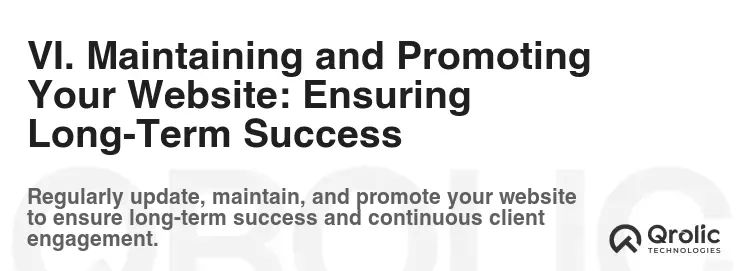
Creating a website is just the first step. You need to maintain and promote it to ensure long-term success.
A. Regularly Updating Content: Keeping Your Website Fresh and Relevant
Keep your website fresh and relevant by regularly updating your content.
- Publish New Blog Posts Regularly: Aim to publish new blog posts at least once a week.
- Update Existing Content: Review and update your existing content regularly to ensure it is accurate and up-to-date.
- Add New Features and Functionality: Add new features and functionality to your website to improve user experience.
Example: Review and update your blog posts on tax law changes every year.
B. Promoting Your Website Online: Driving Traffic and Generating Leads
Promote your website online to drive traffic and generate leads.
- Search Engine Optimization (SEO): Continue to optimize your website for search engines.
- Social Media Marketing: Promote your website on social media platforms.
- Email Marketing: Build an email list and send regular newsletters to your subscribers.
- Paid Advertising: Use paid advertising to drive traffic to your website.
- Content Marketing: Create and distribute valuable content that attracts and engages your target audience.
Example: Share your blog posts on LinkedIn and other social media platforms.
C. Monitoring Website Analytics: Measuring Your Success and Identifying Areas for Improvement
Monitor your website analytics to measure your success and identify areas for improvement.
- Google Analytics: Use Google Analytics to track your website traffic, bounce rate, time on site, and other important metrics.
- Conversion Tracking: Track your website’s conversion rates to see how well your website is converting visitors into leads.
- A/B Testing: Use A/B testing to experiment with different website elements and see which ones perform best.
Example: Use Google Analytics to see which pages on your website are most popular.
VII. Qrolic Technologies and Your Financial Consultancy Website

Qrolic Technologies (https://qrolic.com/) offers a range of services that can help you create and maintain a successful financial consultancy website. Here’s how:
- Website Design and Development: Qrolic Technologies can design and develop a custom website that is tailored to your specific needs and goals.
- SEO Services: Qrolic Technologies can help you optimize your website for search engines and drive more organic traffic.
- Content Marketing Services: Qrolic Technologies can help you create and distribute valuable content that attracts and engages your target audience.
- Social Media Marketing Services: Qrolic Technologies can help you promote your website on social media platforms.
- Website Maintenance and Support: Qrolic Technologies can provide ongoing maintenance and support to ensure your website is always running smoothly.
By partnering with Qrolic Technologies, you can focus on what you do best – providing financial advice to your clients – while they take care of your website.
VIII. Final Thoughts: Building a Website That Builds Your Business

Creating a successful financial consultancy website requires careful planning, execution, and ongoing maintenance. By following the steps outlined in this guide, you can create a website that attracts, engages, and converts visitors into clients. Remember to focus on providing valuable content, building trust, and optimizing your website for search engines. And don’t be afraid to experiment and try new things to see what works best for your business. With dedication and effort, you can build a website that becomes a valuable asset for your financial consultancy. Always remember that your website is not just a digital brochure; it’s a dynamic tool that can help you grow your business and achieve your financial goals. Embrace the challenge, and let your website be the cornerstone of your success.
